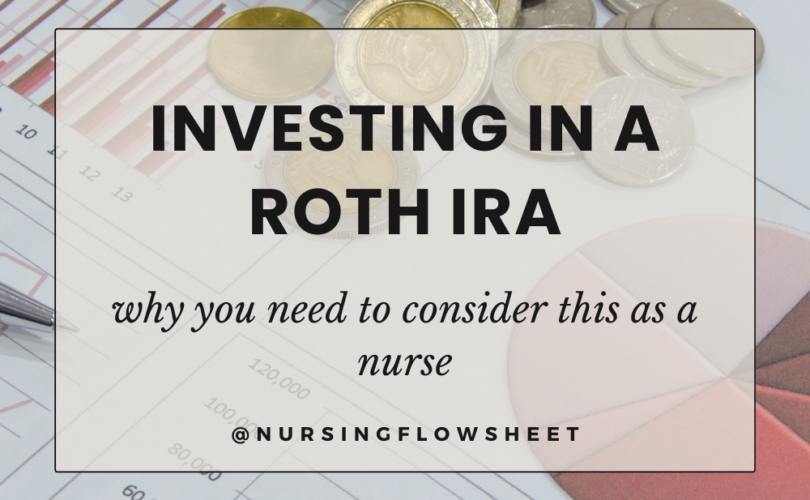For nurses and other healthcare professionals, planning for a secure financial future is just as essential as providing quality patient care. One excellent tool that nurses should consider for long-term financial stability is a Roth IRA (Individual Retirement Account). A Roth IRA offers unique advantages and benefits that can help nurses build a robust retirement nest egg while navigating the challenges of a demanding profession. In this article, we will delve into what a Roth IRA is, how nurses can invest in one, the benefits it offers, and the key rules and income limits associated with this type of retirement account.

Understanding ROTH IRA
A Roth IRA is a type of retirement account that allows individuals to save for retirement while enjoying potential tax-free growth and withdrawals. Unlike traditional IRAs, contributions to a Roth IRA are made with after-tax dollars, which means that you don’t receive an upfront tax deduction for your contributions. However, the key advantage of a Roth IRA lies in its tax treatment upon withdrawal. Qualified withdrawals from a Roth IRA, including both contributions and earnings, are tax-free as long as certain criteria are met.
Investing in a ROTH IRA
Investing in a Roth IRA is relatively straightforward and accessible for nurses. To get started, follow these steps:
- Choose a Financial Institution: First, you’ll need to select a reputable financial institution, such as a bank, credit union, or brokerage, that offers Roth IRA accounts. Compare fees, investment options, and customer service to find the best fit for your needs.
- Open an Account: Once you’ve chosen a financial institution, open a Roth IRA account. This process usually involves providing personal information, selecting beneficiaries, and agreeing to the terms and conditions.
- Make Contributions: After your account is set up, you can begin making contributions. The current annual contribution limit for Roth IRAs (as of 2023) is $6,500 for individuals under the age of 50 and $7,500 for those aged 50 and over (catch-up contribution).
- Choose Investments: Within your Roth IRA, you can select from a wide range of investment options, including stocks, bonds, mutual funds, exchange-traded funds (ETFs), and more. Diversifying your investments can help manage risk and potentially enhance returns over time.

Benefits of Investing in a ROTH IRA
- Tax-Free Withdrawals: One of the primary benefits of a Roth IRA is the ability to make tax-free withdrawals in retirement. This means that the money you withdraw, both contributions and earnings, won’t be subject to federal income taxes as long as you adhere to the withdrawal rules.
- Flexibility: Roth IRAs offer more flexibility than traditional IRAs. Since you’ve already paid taxes on your contributions, you can withdraw your original contributions at any time without penalty or tax implications. This makes a Roth IRA a valuable emergency fund option for nurses.
- No Required Minimum Distributions (RMDs): Unlike traditional IRAs, Roth IRAs do not have required minimum distributions (RMDs) during the account owner’s lifetime. This means you can continue to let your investments grow tax-free for as long as you’d like.
- Estate Planning Benefits: Roth IRAs can be advantageous for estate planning, as they can be passed on to beneficiaries tax-free. This can provide a valuable inheritance for your loved ones.
Income Limits and Rules
While Roth IRAs offer numerous benefits, it’s important to understand the income limits and rules associated with these accounts.
- Income Limits: The Roth IRA income limits for 2023 are less than $153,000 for single tax filers, and less than $228,000 for those married, and filing jointly. If you make more than income limit, you can do a Backdoor ROTH IRA. READ: How to do A Backdoor ROTH IRA
- Contribution Rules: Contributions to a Roth IRA must be made with earned income. If you earn less than the annual contribution limit, you can only contribute up to the amount of your earned income. According to IRS, For 2023, the total contributions you make each year to all of your traditional IRAs and Roth IRAs can’t be more than: $6,500 ($7,500 if you’re age 50 or older), or. If less, your taxable compensation for the year
- Withdrawal Rules: To enjoy tax-free withdrawals, you must meet two main requirements: the Roth IRA must be open for at least five years, and you must be at least 59½ years old. Certain exceptions apply for qualified first-time home purchases and disability.
Conclusion
As nurses dedicate their lives to caring for others, it’s crucial for them to also prioritize their own financial well-being. A Roth IRA provides nurses with an exceptional avenue for building tax-free retirement savings. By understanding what a Roth IRA is, how to invest in one, and the benefits it offers, nurses can take proactive steps toward securing a comfortable retirement. Remember to consider your financial goals, investment preferences, and consult a financial advisor to tailor your Roth IRA strategy to your unique needs and aspirations. Through careful planning and smart investing, nurses can pave the way for a prosperous and fulfilling retirement journey.








